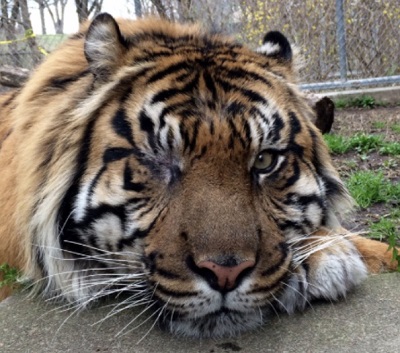
The Louisville Zoo is mourning the death of a Sumatran tiger.
“On Monday, the Louisville Zoo was saddened to say goodbye to Heran, a 16-year-old Sumatran tiger. Heran was suffering from B-cell lymphoma and leukemia, a type of blood cancer; the difficult decision was made to humanely euthanize the male tiger,” zoo officials said in a press release.
Heran was recognizable and popular with guests due to his missing eye, which gave him a permanent “winking” appearance. In 2017, when he arrived in Louisville from the Illinois Miller Park Zoo, Heran had a mature cataract and was diagnosed with glaucoma in his right eye. To ease his pain, the decision was made to surgically replace the eye with a silicone orbital implant. He quickly recovered and acclimated well to his new home.
Sumatran tigers, which are the smallest subspecies of tigers, are endemic to Indonesia and classified as critically endangered. There are only about 75 Sumatran tigers in zoological parks in North America.
Heran came to the Louisville Zoo through a recommendation by the Sumatran Tiger Species Survival Plan (SSP). Unfortunately, despite attempted pairings, he did not sire any cubs.
When Heran was diagnosed with cancer, the zoo faced the tough scenario where they could lose both a beloved animal and an important genetic line in the Sumatran tiger population. However, zoo medical staff are hopeful that the animal ambassador’s legacy will live on. To preserve Heran’s genetic value, the Sumatran Tiger SSP recommended semen collection and gamete rescue as part of the euthanasia plan.
“The priority is to do right by the animal in providing compassionate end-of-life care,” Dr. Zoli Gyimesi, Senior Staff Veterinarian, said. “But if we can also do what is right for the population that Heran represented as an ambassador, that’s our responsibility as well. We hope that the samples we collected will let Heran sire cubs in the future.”
Tissues collected from the tiger after euthanasia were also submitted to researchers at two veterinary universities. One university is part of an effort to biobank and characterize cancers across zoo species, and the other conducts research stem cell therapies for living tigers.
“With every sad loss,” Zoo Director Dan Maloney stated, “we try to maximize what can be learned to benefit future generations of animals.”
A celebration video of Heran at the Louisville Zoo is available by clicking here.
By Ken Howlett, News Director
Contact Ken at ken@k105.com








